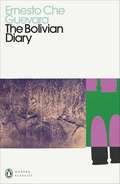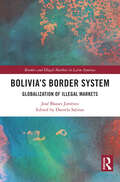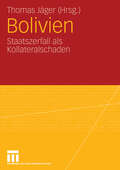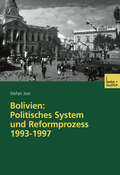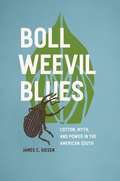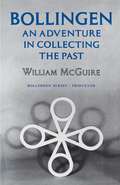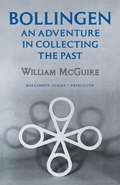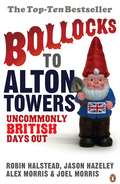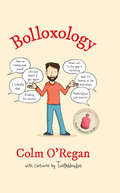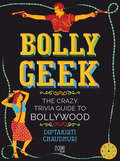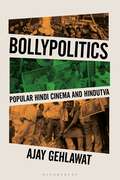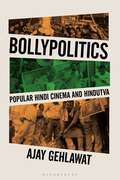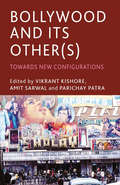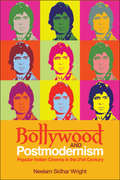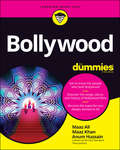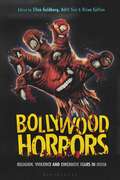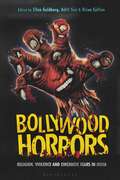- Table View
- List View
The Bolivian Diary (Penguin Modern Classics)
by Ernesto Che Guevara'Guevara was a figure of epic proportions. These diaries, stark and moving, will be his most enduring monument' ObserverThe final diaries of Che Guevara begin in 1966, when he travelled to Bolivia to foment a revolution, and end just two days before his death in October 1967. They form an unvarnished account of his guerrilla campaign against CIA-backed Bolivian troops, fighting in the jungle and keeping his men's spirits up - even as the struggle started to fail. Found in Guevara's backpack and smuggled to Cuba after his execution, The Bolivian Diary is an inspiring record of, and a moving memorial to, a revolutionary life.
Bolivia's Border System: A Globalization of Illegal Markets (Borders and Illegal Markets in Latin America)
by José Blanes JiménezThis volume demonstrates how Bolivia is part of a regional border system and intends to contribute to public policies, related to violence and distortions stemming from global illegal markets, specifically for vulnerable populations. The book offers a multinational investigation on the changing and unknown image of the relationship systems that surround countries and, in particular, the structuring and functions of their borders. The chapters offer a reflection on how the lines of borders connect us to distant regions, which defines the real scope of the borders of globalization, while also impacting trade, labor flows, and organized crime. The book reveals how Bolivia has advanced from an image of borders, built through territorial disputes with neighbors, to today’s conception of them. In doing so, it argues that underlying tensions have developed between the local and the global, namely, Bolivia inserting itself into the global system of illegal markets, thereby generating critical scenarios for various social groups. Bolivia's Border System comprises the first research into Bolivia’s border subsystem and illegal markets. It will be a vital resource for researchers of Bolivia and Bolivian history, international relations, security studies, border studies, and contemporary Latin America.
Bolivia's Border System: A Globalization of Illegal Markets (Borders and Illegal Markets in Latin America)
by José Blanes JiménezThis volume demonstrates how Bolivia is part of a regional border system and intends to contribute to public policies, related to violence and distortions stemming from global illegal markets, specifically for vulnerable populations. The book offers a multinational investigation on the changing and unknown image of the relationship systems that surround countries and, in particular, the structuring and functions of their borders. The chapters offer a reflection on how the lines of borders connect us to distant regions, which defines the real scope of the borders of globalization, while also impacting trade, labor flows, and organized crime. The book reveals how Bolivia has advanced from an image of borders, built through territorial disputes with neighbors, to today’s conception of them. In doing so, it argues that underlying tensions have developed between the local and the global, namely, Bolivia inserting itself into the global system of illegal markets, thereby generating critical scenarios for various social groups. Bolivia's Border System comprises the first research into Bolivia’s border subsystem and illegal markets. It will be a vital resource for researchers of Bolivia and Bolivian history, international relations, security studies, border studies, and contemporary Latin America.
Bolivien: Staatszerfall als Kollateralschaden
by Thomas JägerDas Interesse an der politischen, sozialen und ökonomischen Entwicklung Boliviens hat in den letzten Jahren erheblich zugenommen; denn Bolivien ist von dem Weg der US-amerikanisch inspirierten Wirtschaftsreformen abgewichen, nachdem sich dieser als Sackgasse erwiesen hatte. Neben Venezuela gilt Bolivien heute als zweite Stütze eines Sozialismus des 21. Jahrhunderts. In diesem Buch geht es darum, die Entwicklungen Boliviens nachzuzeichnen, die das Land in den letzten Jahren und Jahrzehnten an den Rand des politischen Scheiterns geführt haben.
Bolivien: Politisches System und Reformprozess 1993–1997
by Stefan JostDas Buch ist die bislang umfassendste Darstellung des politischen Systems Boliviens, in der nicht nur der lateinamerikanische Kontext der Präsidentialismus/Parlamentarismus-Diskussion, sondern auch der international beachtete Reformprozess der Jahre 1993-1997 analysiert wird.
Boll Weevil Blues: Cotton, Myth, and Power in the American South
by James C. GiesenBetween the 1890s and the early 1920s, the boll weevil slowly ate its way across the Cotton South from Texas to the Atlantic Ocean. At the turn of the century, some Texas counties were reporting crop losses of over 70 percent, as were areas of Louisiana, Arkansas, and Mississippi. By the time the boll weevil reached the limits of the cotton belt, it had destroyed much of the region’s chief cash crop—tens of billions of pounds of cotton, worth nearly a trillion dollars. As staggering as these numbers may seem, James C. Giesen demonstrates that it was the very idea of the boll weevil and the struggle over its meanings that most profoundly changed the South—as different groups, from policymakers to blues singers, projected onto this natural disaster the consequences they feared and the outcomes they sought. Giesen asks how the myth of the boll weevil’s lasting impact helped obscure the real problems of the region—those caused not by insects, but by landowning patterns, antiquated credit systems, white supremacist ideology, and declining soil fertility. Boll Weevil Blues brings together these cultural, environmental, and agricultural narratives in a novel and important way that allows us to reconsider the making of the modern American South.
Boll Weevil Blues: Cotton, Myth, and Power in the American South
by James C. GiesenBetween the 1890s and the early 1920s, the boll weevil slowly ate its way across the Cotton South from Texas to the Atlantic Ocean. At the turn of the century, some Texas counties were reporting crop losses of over 70 percent, as were areas of Louisiana, Arkansas, and Mississippi. By the time the boll weevil reached the limits of the cotton belt, it had destroyed much of the region’s chief cash crop—tens of billions of pounds of cotton, worth nearly a trillion dollars. As staggering as these numbers may seem, James C. Giesen demonstrates that it was the very idea of the boll weevil and the struggle over its meanings that most profoundly changed the South—as different groups, from policymakers to blues singers, projected onto this natural disaster the consequences they feared and the outcomes they sought. Giesen asks how the myth of the boll weevil’s lasting impact helped obscure the real problems of the region—those caused not by insects, but by landowning patterns, antiquated credit systems, white supremacist ideology, and declining soil fertility. Boll Weevil Blues brings together these cultural, environmental, and agricultural narratives in a novel and important way that allows us to reconsider the making of the modern American South.
Boll Weevil Blues: Cotton, Myth, and Power in the American South
by James C. GiesenBetween the 1890s and the early 1920s, the boll weevil slowly ate its way across the Cotton South from Texas to the Atlantic Ocean. At the turn of the century, some Texas counties were reporting crop losses of over 70 percent, as were areas of Louisiana, Arkansas, and Mississippi. By the time the boll weevil reached the limits of the cotton belt, it had destroyed much of the region’s chief cash crop—tens of billions of pounds of cotton, worth nearly a trillion dollars. As staggering as these numbers may seem, James C. Giesen demonstrates that it was the very idea of the boll weevil and the struggle over its meanings that most profoundly changed the South—as different groups, from policymakers to blues singers, projected onto this natural disaster the consequences they feared and the outcomes they sought. Giesen asks how the myth of the boll weevil’s lasting impact helped obscure the real problems of the region—those caused not by insects, but by landowning patterns, antiquated credit systems, white supremacist ideology, and declining soil fertility. Boll Weevil Blues brings together these cultural, environmental, and agricultural narratives in a novel and important way that allows us to reconsider the making of the modern American South.
Boll Weevil Blues: Cotton, Myth, and Power in the American South
by James C. GiesenBetween the 1890s and the early 1920s, the boll weevil slowly ate its way across the Cotton South from Texas to the Atlantic Ocean. At the turn of the century, some Texas counties were reporting crop losses of over 70 percent, as were areas of Louisiana, Arkansas, and Mississippi. By the time the boll weevil reached the limits of the cotton belt, it had destroyed much of the region’s chief cash crop—tens of billions of pounds of cotton, worth nearly a trillion dollars. As staggering as these numbers may seem, James C. Giesen demonstrates that it was the very idea of the boll weevil and the struggle over its meanings that most profoundly changed the South—as different groups, from policymakers to blues singers, projected onto this natural disaster the consequences they feared and the outcomes they sought. Giesen asks how the myth of the boll weevil’s lasting impact helped obscure the real problems of the region—those caused not by insects, but by landowning patterns, antiquated credit systems, white supremacist ideology, and declining soil fertility. Boll Weevil Blues brings together these cultural, environmental, and agricultural narratives in a novel and important way that allows us to reconsider the making of the modern American South.
Bollingen: An Adventure in Collecting the Past (PDF)
by William McguireThis lively, intimate, sometimes disrespectful, but always knowledgeable history of the Bollingen Foundation confirms its pervasive influence on American intellectual life. Conceived by Paul and Mary Mellon as a means of publishing in English the collected works of C. G. Jung, the Foundation broadened to encompass scholarship and publication in a remarkable number of fields. Here are wonderful portraits of the central figures, including the Mellons, Jung himself, Heinrich Zimmer, Joseph Campbell, D. T. Suzuki, Natacha Rambova, Vladimir Nabokov, Gershom Scholem, Herbert Read, and Kurt and Helen Wolff.
Bollingen: An Adventure in Collecting the Past - Updated Edition (Bollingen Series (General) #654)
by William McGuireThis lively, intimate, sometimes disrespectful, but always knowledgeable history of the Bollingen Foundation confirms its pervasive influence on American intellectual life. Conceived by Paul and Mary Mellon as a means of publishing in English the collected works of C. G. Jung, the Foundation broadened to encompass scholarship and publication in a remarkable number of fields. Here are wonderful portraits of the central figures, including the Mellons, Jung himself, Heinrich Zimmer, Joseph Campbell, D. T. Suzuki, Natacha Rambova, Vladimir Nabokov, Gershom Scholem, Herbert Read, and Kurt and Helen Wolff.
Bollocks to Alton Towers: Uncommonly British Days Out (Bollocks to Alton Towers #1)
by Joel Morris Jason Hazeley Alex Morris Robin HalsteadThe British Lawnmower Museum, Keith Harding's World of Mechanical Music and Mad Jack's Sugar Loaf. In a world of theme parks, interactive exhibits, over-priced merchandise and queues, don't worry, these are names to stir the soul. Reassuring evidence that there's still somewhere to turn in search of the small, fascinating, unique and, dammit, British.In a stumbling journey across the country in search of the best we have to offer our intrepid heroes discovered dinosaurs in South London, a cold war castle in Essex, grown men pretending to be warships in Scarborough, unexplained tunnels under Liverpool and a terraced house in Bedford being kept warm for Jesus's return. And along the way they met the people behind them all: enthusiasts, eccentrics and, you know, those who just sort of fell into looking after a vast collection of gnomes ...Makes you proud!
Bolloxology: An Unreliable Guide To Ireland
by Colm O'ReganLet me ask you a question.Have you ever wondered why pretentiousness, jargon, bullshit and Having Notions Above Our Station are so rife in the world today? Well, there’s now a recognized science that studies all of these forms of self-delusion. Welcome to the world of Bolloxology.We might not know it, but the modern world has subjected all of us to some form of Bolloxology. It’s that moment when you’ve paid twenty euro for fish and chips just so it can be served on a piece of slate. It’s when you share yet another Inspirational Quote of the Day against your better judgement. It’s when you realize you haven’t understood a word That Politician has said to you on your doorstep, yet you feel strangely compelled to take a selfie with him. It’s about the passion, the ‘key learnings’, the artisan chutney, the instacelebs. It’s about the Pure Hames we’re making of things.In Bolloxology, Colm O’Regan, comedian and author of the bestselling Irish Mammies books, shows that our world is now less a planet and more a hot air balloon. Illustrated by the hilarious Twisted Doodles, Bolloxology is an indispensable guide to the deceptive cod-infested seas of twenty-first-century life.
Bollygeek
by Diptakirti ChaudhuriMERE PAAS…BOLLYWOOD TRIVIA HAI! The Indian cine-goer’s fascination for Bollywood is unending – and then there are those who really like to get their elbows into it dum lagaa ke! Which is why this book, stuffed with super-gyaan (yes, there is a science to the movies as well!) and sprinkled with quirky illustrations is a must-have for anyone in love with or just plain confused by all that goes on in Bollywood. Among the many masaaledar nuggets it features are: • The rulebook on how to plan a filmi elopement; • Fifteen jailers who terrorized prisoners (and the jailbreaks that had wardens quaking at the knees); • Colourful stories that reveal why people get drunk in the movies; • Ten on-screen detectives who had crime on their minds, even if they could never solve them; • Three ways suhaag raats unfold *cough* in Hindi cinema. And there’s much more! From tragedy and mystery to heartbreak and victory – Bollygeek opens up the obsessive, compulsive and addictive world of Hindi cinema like never before. You don’t want to miss out on this one!
Bollypolitics: Popular Hindi Cinema and Hindutva (World Cinema)
by Ajay GehlawatThis book provides an in-depth exploration of the evolving landscape of Bollywood cinema in response to recent socio-political changes in India, including a surge in sectarian violence and the ascent of Hindutva, or Hindu nationalism, under Prime Minister Narendra Modi's leadership. Through a comprehensive analysis of prominent filmmakers and actors like Sanjay Leela Bhansali, Kangana Ranaut, Akshay Kumar, and Anupam Kher, Ajay Gehlawat investigates the extent to which their recent works align with key tenets of the Hindutva movement. He scrutinizes the growing influence of the Bharatiya Janata Party (BJP) on film production, manifesting in collaborations covering diverse themes, from Modi's Clean India initiative to the nation's space exploration endeavors and grand historical epics such as Padmaavat (2018) and Manikarnika (2019) that seek to reshape Indian history in line with Hindutva ideology.Gehlawat goes on to dissect smaller budget films like Article 15 (2019) and Shubh Mangal Zyada Saavdhan (2020), which tackle pressing social issues like caste-based violence and homophobia exacerbated by the surge in right-wing extremism in India. In doing so, he elucidates the profound and far-reaching impact of Hindutva ideology on Indian cinematic narratives and aesthetics, while also considering the broader implications for Indian society as a whole.
Bollypolitics: Popular Hindi Cinema and Hindutva (World Cinema)
by Ajay GehlawatThis book provides an in-depth exploration of the evolving landscape of Bollywood cinema in response to recent socio-political changes in India, including a surge in sectarian violence and the ascent of Hindutva, or Hindu nationalism, under Prime Minister Narendra Modi's leadership. Through a comprehensive analysis of prominent filmmakers and actors like Sanjay Leela Bhansali, Kangana Ranaut, Akshay Kumar, and Anupam Kher, Ajay Gehlawat investigates the extent to which their recent works align with key tenets of the Hindutva movement. He scrutinizes the growing influence of the Bharatiya Janata Party (BJP) on film production, manifesting in collaborations covering diverse themes, from Modi's Clean India initiative to the nation's space exploration endeavors and grand historical epics such as Padmaavat (2018) and Manikarnika (2019) that seek to reshape Indian history in line with Hindutva ideology.Gehlawat goes on to dissect smaller budget films like Article 15 (2019) and Shubh Mangal Zyada Saavdhan (2020), which tackle pressing social issues like caste-based violence and homophobia exacerbated by the surge in right-wing extremism in India. In doing so, he elucidates the profound and far-reaching impact of Hindutva ideology on Indian cinematic narratives and aesthetics, while also considering the broader implications for Indian society as a whole.
Bollywood and its Other(s): Towards New Configurations
by Vikrant Kishore Amit Sarwal Parichay PatraHow do we define the globalized cinema and media cultures of Bollywood in an age when it has become part of the cultural diplomacy of an emerging superpower? Bollywood and Its Other(s) explores the aesthetic-philosophical questions of the other through, for example, discussions on Indian diaspora's negotiations with national identity.
Bollywood and Postmodernism: Popular Indian Cinema in the 21st Century
by Neelam Sidhar Wright‘New Bollywood’ has arrived, but its postmodern impulse often leaves film scholars reluctant to theorise its aesthetics. How do we define the style of a contemporary Bollywood film? Are Bollywood films just uninspired Hollywood rip-offs, or does their borrowing signal genuine innovation within the industry? Applying postmodern concepts and locating postmodern motifs in key commercial Hindi films, this innovative study reveals how Indian cinema has changed in the 21st century. Equipping readers with an alternative method of reading contemporary Indian cinema, Bollywood and Postmodernism takes Indian film studies beyond the exhausted theme of diaspora, and exposes a new decade of aesthetic experimentation and textual appropriation in mainstream Bombay cinema. A bold celebration of contemporary Bollywood texts, this book radically redefines Indian film and persuasively argues for its seriousness as a field of study in world cinema.
Bollywood and Postmodernism: Popular Indian Cinema in the 21st Century
by Neelam Sidhar Wright‘New Bollywood’ has arrived, but its postmodern impulse often leaves film scholars reluctant to theorise its aesthetics. How do we define the style of a contemporary Bollywood film? Are Bollywood films just uninspired Hollywood rip-offs, or does their borrowing signal genuine innovation within the industry? Applying postmodern concepts and locating postmodern motifs in key commercial Hindi films, this innovative study reveals how Indian cinema has changed in the 21st century. Equipping readers with an alternative method of reading contemporary Indian cinema, Bollywood and Postmodernism takes Indian film studies beyond the exhausted theme of diaspora, and exposes a new decade of aesthetic experimentation and textual appropriation in mainstream Bombay cinema. A bold celebration of contemporary Bollywood texts, this book radically redefines Indian film and persuasively argues for its seriousness as a field of study in world cinema.
Bollywood Cinema: Temples of Desire
by Vijay MishraIndia is home to Bollywood - the largest film industry in the world. Movie theaters are said to be the "temples of modern India," with Bombay producing nearly 800 films per year that are viewed by roughly 11 million people per day. In Bollywood Cinema, Vijay Mishra argues that Indian film production and reception is shaped by the desire for national community and a pan-Indian popular culture. Seeking to understand Bollywood according to its own narrative and aesthetic principles and in relation to a global film industry, he views Indian cinema through the dual methodologies of postcolonial studies and film theory. Mishra discusses classics such as Mother India (1957) and Devdas (1935) and recent films including Ram Lakhan (1989) and Khalnayak (1993), linking their form and content to broader issues of national identity, epic tradition, popular culture, history, and the implications of diaspora.
Bollywood Cinema: Temples of Desire
by Vijay MishraIndia is home to Bollywood - the largest film industry in the world. Movie theaters are said to be the "temples of modern India," with Bombay producing nearly 800 films per year that are viewed by roughly 11 million people per day. In Bollywood Cinema, Vijay Mishra argues that Indian film production and reception is shaped by the desire for national community and a pan-Indian popular culture. Seeking to understand Bollywood according to its own narrative and aesthetic principles and in relation to a global film industry, he views Indian cinema through the dual methodologies of postcolonial studies and film theory. Mishra discusses classics such as Mother India (1957) and Devdas (1935) and recent films including Ram Lakhan (1989) and Khalnayak (1993), linking their form and content to broader issues of national identity, epic tradition, popular culture, history, and the implications of diaspora.
Bollywood For Dummies
by Maaz Ali Maaz Khan Anum HussainTake the trip of a lifetime into the past and present of Bollywood Fascinated by the high energy, high emotion, high color, endless dance routines, and sheer scale of Bollywood—but afraid you'll never really know your Ghazals from your Qawwalis, or your Khans from your Kapoors? Well, in the immortal line from the Hindi-language blockbuster Sultan, "No one can defeat you unless you accept defeat yourself," and there's no need to be defeated at all when you can sit back with Bollywood For Dummies and immerse yourself in the glamorous whirl of one of the most exciting movie industries on Earth. Starting with the time-travel adventure of the book’s main feature—the history of the Hindi-speaking industry from people and events of early to mid 20th century Mumbai—you'll also journey in space, taking fascinating documentary side trips to get to know Tollywood’s Telegu-language cinema in southern India, as well as the growing influence of Lollywood across the border in Pakistan. Written by the cohosts of Desi Standard Time, a podcast that explores Bollywood and South Asian movies and media, you'll see how the unique cinema culture of Bollywood in particular has become a global phenomenon, reflecting the rise of India as an independent nation and presenting its long history—and it’s exciting and multifaceted present—in new, influential, and enduring forms. Whatever you paid the price of entry for: the popular Bollywood "Masala" movie style that emphasizes music, comedy, romance, and action; sensitive critiques of a fast-changing society by the Indian Social Realism movement; new forms of music from Indian disco to Sufi boogie; or a look at the lives and talents of the great acting dynasties—it's all here. And there'll still be plenty more plot twists beyond these to surprise and delight you. Get to know the people who built Bollywood Discover the main music and dance styles Explore and recognize Bollywood’s influence on Western cinema Go social and join up with the liveliest Bollywood fan communities You're right to be excited: for newbies a whole new world awaits, and for aficionados, there's always so much more to know. So, sit back with this book, grab some popcorn or a plate of samosas—or why not both—and prepare to begin an electric feast to sizzle all your senses.
Bollywood For Dummies
by Maaz Ali Maaz Khan Anum HussainTake the trip of a lifetime into the past and present of Bollywood Fascinated by the high energy, high emotion, high color, endless dance routines, and sheer scale of Bollywood—but afraid you'll never really know your Ghazals from your Qawwalis, or your Khans from your Kapoors? Well, in the immortal line from the Hindi-language blockbuster Sultan, "No one can defeat you unless you accept defeat yourself," and there's no need to be defeated at all when you can sit back with Bollywood For Dummies and immerse yourself in the glamorous whirl of one of the most exciting movie industries on Earth. Starting with the time-travel adventure of the book’s main feature—the history of the Hindi-speaking industry from people and events of early to mid 20th century Mumbai—you'll also journey in space, taking fascinating documentary side trips to get to know Tollywood’s Telegu-language cinema in southern India, as well as the growing influence of Lollywood across the border in Pakistan. Written by the cohosts of Desi Standard Time, a podcast that explores Bollywood and South Asian movies and media, you'll see how the unique cinema culture of Bollywood in particular has become a global phenomenon, reflecting the rise of India as an independent nation and presenting its long history—and it’s exciting and multifaceted present—in new, influential, and enduring forms. Whatever you paid the price of entry for: the popular Bollywood "Masala" movie style that emphasizes music, comedy, romance, and action; sensitive critiques of a fast-changing society by the Indian Social Realism movement; new forms of music from Indian disco to Sufi boogie; or a look at the lives and talents of the great acting dynasties—it's all here. And there'll still be plenty more plot twists beyond these to surprise and delight you. Get to know the people who built Bollywood Discover the main music and dance styles Explore and recognize Bollywood’s influence on Western cinema Go social and join up with the liveliest Bollywood fan communities You're right to be excited: for newbies a whole new world awaits, and for aficionados, there's always so much more to know. So, sit back with this book, grab some popcorn or a plate of samosas—or why not both—and prepare to begin an electric feast to sizzle all your senses.
Bollywood Horrors: Religion, Violence and Cinematic Fears in India
by Ellen Goldberg, Aditi Sen, and Brian CollinsBollywood Horrors is a wide-ranging collection that examines the religious aspects of horror imagery, representations of real-life horror in the movies, and the ways in which Hindi films have projected cinematic fears onto the screen. Part one, “Material Cultures and Prehistories of Horror in South Asia” looks at horror movie posters and song booklets and the surprising role of religion in the importation of Gothic tropes into Indian films, told through the little-known story of Sir Devendra Prasad Varma. Part two, “Cinematic Horror, Iconography and Aesthetics” examines the stereotype of the tantric magician found in Indian literature beginning in the medieval period, cinematic representations of the myth of the fearsome goddess Durga's slaying of the Buffalo Demon, and the influence of epic mythology and Hollywood thrillers on the 2002 film Raaz. The final part, “Cultural Horror,” analyzes elements of horror in Indian cinema's depiction of human trafficking, shifting gender roles, the rape-revenge cycle, and communal violence.
Bollywood Horrors: Religion, Violence and Cinematic Fears in India
Bollywood Horrors is a wide-ranging collection that examines the religious aspects of horror imagery, representations of real-life horror in the movies, and the ways in which Hindi films have projected cinematic fears onto the screen. Part one, “Material Cultures and Prehistories of Horror in South Asia” looks at horror movie posters and song booklets and the surprising role of religion in the importation of Gothic tropes into Indian films, told through the little-known story of Sir Devendra Prasad Varma. Part two, “Cinematic Horror, Iconography and Aesthetics” examines the stereotype of the tantric magician found in Indian literature beginning in the medieval period, cinematic representations of the myth of the fearsome goddess Durga's slaying of the Buffalo Demon, and the influence of epic mythology and Hollywood thrillers on the 2002 film Raaz. The final part, “Cultural Horror,” analyzes elements of horror in Indian cinema's depiction of human trafficking, shifting gender roles, the rape-revenge cycle, and communal violence.
